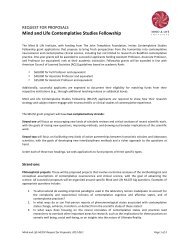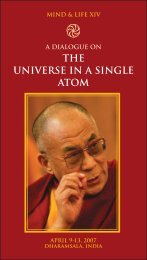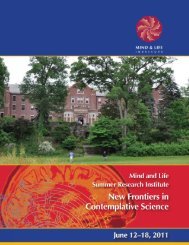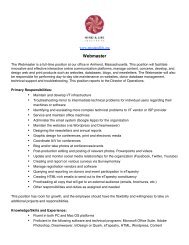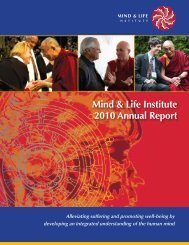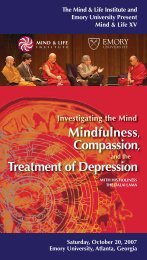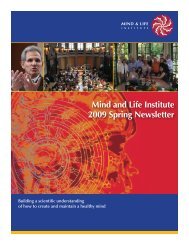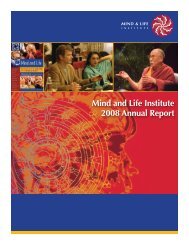to view the brochure from the conference (PDF). - Mind & Life Institute
to view the brochure from the conference (PDF). - Mind & Life Institute
to view the brochure from the conference (PDF). - Mind & Life Institute
You also want an ePaper? Increase the reach of your titles
YUMPU automatically turns print PDFs into web optimized ePapers that Google loves.
PROGRAM OVERVIEW OVERVIEW<br />
Attention, Memory, and <strong>the</strong> <strong>Mind</strong>:<br />
A Synergy of Psychological, Neuroscientific,<br />
and Contemplative Perspectives<br />
The <strong>to</strong>pics of <strong>Mind</strong> and <strong>Life</strong> XVIII are human attention, memory, and <strong>the</strong> mind<br />
considered <strong>from</strong> phenomenological (including contemplative), psychological, and<br />
neurobiological perspectives. While <strong>the</strong> relation between attention, memory, and <strong>the</strong><br />
mind is a fascinating area of research in psychological science and neuroscience, it is<br />
also of particular interest and investigation in Buddhism, because it is through <strong>the</strong><br />
contemplative refinement of attention and mindfulness that one explores <strong>the</strong><br />
distinctive characteristics, origins, and potentials of human awareness, of suffering,<br />
and of genuine happiness. In short, <strong>the</strong> contemplative training known as “shamatha”<br />
(meditative quiescence) deals with <strong>the</strong> development and refinement of attention; and<br />
this is <strong>the</strong> basis for “vipashyana” (contemplative insight), which entails methods for<br />
experientially exploring <strong>the</strong> nature of <strong>the</strong> mind and its relation <strong>to</strong> <strong>the</strong> world at large.<br />
Fur<strong>the</strong>rmore, sustained voluntary attention (samadhi) is closely related <strong>to</strong> memory,<br />
because in order <strong>to</strong> deliberately sustain one’s attention upon a chosen object, one<br />
must continue <strong>to</strong> remember <strong>to</strong> do so <strong>from</strong> moment <strong>to</strong> moment, faithfully returning<br />
back <strong>to</strong> refocus on that object whenever <strong>the</strong> mind wanders away <strong>from</strong> it. Likewise, in<br />
Buddhism, <strong>the</strong> faculty of “mindfulness” (smrti) refers not only <strong>to</strong> moment-<strong>to</strong>moment<br />
awareness of present events. Instead, <strong>the</strong> primary connotation of this<br />
Sanskrit term (and its corresponding Pali term sati) is recollection. This includes<br />
long-term, short-term, and working memory, non-forgetful, present-centered<br />
awareness, and also prospective memory, i.e., remembering <strong>to</strong> be aware of something<br />
or <strong>to</strong> do something at a designated time in <strong>the</strong> future. In <strong>the</strong>se ways, <strong>from</strong> a contemplative<br />
perspective, memory is critically linked <strong>to</strong> attention, and both of <strong>the</strong>se mental<br />
faculties have important ramifications for <strong>the</strong> experiential and phenomenological<br />
study of <strong>the</strong> mind, its training, and potential optimization.<br />
The discussions during <strong>Mind</strong> and <strong>Life</strong> XVIII will primarily focus on <strong>the</strong> subjective<br />
phenomenology, information-processing operations, and neural mechanisms of<br />
attention, memory, and conscious awareness <strong>from</strong> both scientific and Buddhist<br />
perspectives. We expect that participants in <strong>the</strong>se dialogues, coming <strong>from</strong> <strong>the</strong> various<br />
disciplines of philosophy, psychology, neuroscience, and Buddhist scholarship and<br />
contemplative practice will especially work <strong>to</strong>ward understanding and incorporating<br />
<strong>the</strong> broad range of each o<strong>the</strong>rs’ ideas and <strong>view</strong>s about <strong>the</strong> <strong>to</strong>pics of this meeting.<br />
Special attention will be focused on <strong>the</strong> distinctive characteristics and interactions of<br />
attention, memory, and metacognition as seen <strong>from</strong> diverse <strong>view</strong>points, including <strong>the</strong><br />
possibility of multiple dimensions of awareness (not limiting <strong>the</strong> discussion <strong>to</strong> <strong>the</strong><br />
familiar categories of <strong>the</strong> conscious and subconscious mind), and <strong>the</strong> relationship<br />
between <strong>the</strong> entire spectrum of human information processing, awareness, and <strong>the</strong><br />
world of experience (Lebenswelt) as a whole. We anticipate that this exploration will<br />
lead <strong>to</strong> fur<strong>the</strong>r systematic plans for ground-breaking empirical and <strong>the</strong>oretical<br />
research on meditation and contemplative practice at <strong>the</strong> interface between science<br />
and Buddhism. Participants will be prepared <strong>to</strong> interact collaboratively <strong>to</strong>ward<br />
developing such an exciting research agenda.<br />
3



